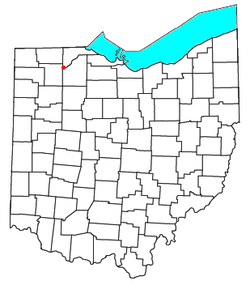Providence, Ohio
| Providence, Ohio | |
|---|---|
| Ghost town | |

Lock #44 in Providence Metropark
|
|
 Location of Providence, Ohio |
|
| Coordinates: 41°25′05″N 83°52′20″W / 41.41806°N 83.87222°WCoordinates: 41°25′05″N 83°52′20″W / 41.41806°N 83.87222°W | |
| Country | United States |
| State | Ohio |
| County | Lucas |
| Township | Providence |
| Time zone | Eastern (EST) (UTC-5) |
| • Summer (DST) | EDT (UTC-4) |
Providence is a ghost town on the north side of the Maumee River in southern Providence Township, Lucas County, Ohio, United States, about 24 miles (39 km) southwest of Toledo. After suffering a destructive fire and a cholera epidemic in mid-19th century, the village was abandoned. In this period, canal traffic had also fallen off.
The area is now maintained as Providence Metropark of Toledo, featuring numerous elements of the canal era, including a mule-drawn canal boat on a restored section of the Miami and Erie Canal, and an operating saw and gristmill.
The village of Providence was founded by a French Canadian, Peter Manor, who was the first white man to settle upriver on the Maumee River away from Lake Erie. He arrived there in 1816 in order to establish a fur trading post for the North West Fur Company, then based in Montreal, Canada. But the United States prohibited Canadian traders from operating below the border and he was closed down.
In 1822, Manor had a sawmill erected next to the river, and a gristmill was built in 1835. This was about 24 miles from the river's mouth on Maumee Bay, where there was still an Odawa people village, part of a 34-square mile reserve on the south side of the river.
As the number of settlers increased in Ohio, promoters of the state discussed a proposal for a Miami and Erie Canal to improve transportation to the southwest parts of the state and connect them to markets on and served by Lake Erie. Manor platted the town to prepare for anticipated development. In 1837, the State of Ohio granted Manor a contract to begin construction, and the town was soon open for business. By 1843, some of the eighty-eight lots laid out were vacated. The village was, in general, considered a favorable place to live by the westward settlers. It was often seen as a haven from the problems of lawlessness, drinking, fighting, and crime that began to plague Ohio canal towns.
...
Wikipedia
